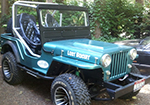I received an email with the following question. We are nearly home and I don’t have time to research it. Anyone know the answer?
I’m currently rebuilding, for a customer, a 1940 willys 4 cyl. It has babbitted connecting rods and I was wondering if standard later model rods could be substituted?

The process to re babbitt can be expensive but a good machine shop should be able to do it. Newer rods and two piece bearings can be put in in place.
Babbitt metal is most commonly used in bulk bearing material. Babbitt metal is characterized by its resistance to galling. It’s soft and easily damaged, which suggests that it might be unsuitable for a bearing surface. However, its structure is made up of small hard crystals dispersed in a softer metal, which makes it a metal matrix composite. As the bearing wears, the softer metal erodes somewhat, which creates paths for lubricant between the hard high spots that provide the actual bearing surface. When tin is used as the softer metal, friction causes the tin to melt and function as a lubricant, which protects the bearing from wear when other lubricants are absent.
Until the mid-1950s, poured Babbitt bearings were common in automotive applications. The Babbitt was poured into the block or caps using a form. Tin-based Babbitts were used as they could stand up to the impact loads found on the connecting rods and crankshaft. The poured Babbitt bearings were kept thin. The rods and caps would have shims that could be peeled off as the Babbitt wore
A little web description of babbitt bearings.